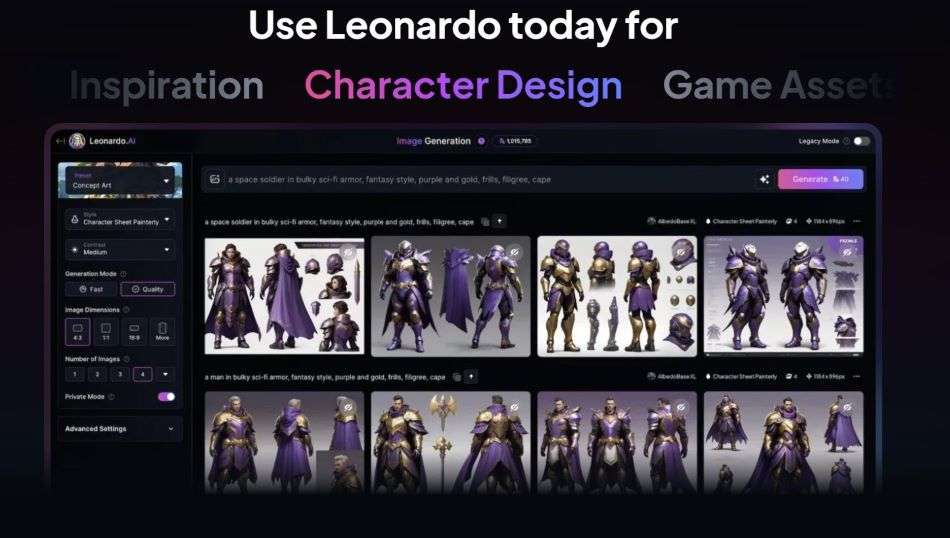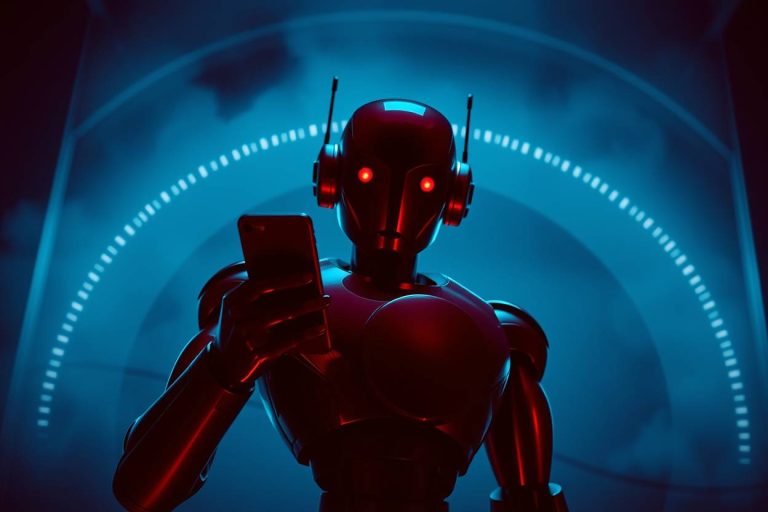How to create and monetize AI character generators in 8 easy steps

In today’s digital world, creating characters has become easier than ever. Writers, game developers, artists, and marketers now have access to smart tools that simplify every part of the character creation process—from choosing names and personalities to designing unique looks. This guide covers how these tools work, how to get started, and how to turn your characters into something profitable.
Key Takeaways
- AI Character Generators Simplify Creation: AI tools make it easy to design characters with custom looks, personalities, voices, and backgrounds.
- Variety of Generators Available: Different generators offer options for names, full profiles, visual designs, and voices to build complete characters.
- High Demand in Key Industries: Gaming, digital art, and social media industries are using AI-generated characters, creating strong monetization potential.
- Accessible Platforms: Tools like Midjourney, Leonardo AI, and Runway ML make creating, animating, and voicing characters simple for all skill levels.
- Monetization Opportunities: Sell or license characters, start a YouTube channel, or offer custom character services to profit from your creations.
Understanding AI character generators
AI character generators are tools that help you create complete characters, including both their visual design and personality, with minimal effort. They come in two main types:
- Text-Based Generators: These focus on creating character names, backstories, personalities, and dialogue. You can input descriptions, and the AI will suggest traits or generate a character profile based on your prompts.
- Image Generators: These use AI to produce character visuals, creating images of characters based on descriptions you provide. By specifying details like physical attributes, clothing, or art style (e.g., anime, fantasy, or realistic), the AI combines these elements to produce a unique AI-generated character image that matches your vision.
How They Work: AI character generators use patterns learned from large datasets, so when you give them a prompt, they recognize and combine similar features to create a complete character. Whether it’s a personality profile or a visual design, the AI delivers characters that feel well-rounded and ready to use for stories, games, or art.
Types of character generators
- Character Name Generator: Generates unique and culturally appropriate names for characters across different genres.
- Random Character Generator: Creates complete character profiles with randomized attributes for inspiration.
- Character Design Generator: Produces visual representations based on specified parameters like style, attire, and physical features.
- Character Description Generator: Provides detailed textual descriptions, including appearance, background, and traits.
- Anime Character Generator: Specializes in crafting characters in the anime art style, capturing the essence of this popular genre.
- Character Voice Generator: Synthesizes voices, giving characters an auditory identity.
The Booming market for AI-generated characters
The global gaming industry, a primary consumer of character assets, has reached $209.7 billion in 2023 and is projected to grow 13.7% per year, according to a report by Market Research Future. With indie developers and major studios alike seeking unique assets, the demand for high-quality character designs is at an all-time high.
Similarly, the digital art market is expanding, with platforms like ArtStation and DeviantArt showcasing countless creators leveraging AI tools to enhance their work. This surge presents lucrative opportunities for creatives to monetize their AI characters.
Character generators – Top AI Tools
Harnessing the right tools is crucial for bringing your characters to life. Let’s delve into some cutting-edge AI character generators that stand out for their quality and capabilities.
1. Leonardo AI
Leonardo AI is a state-of-the-art platform designed for generating high-quality images based on different styles ranging from fantasy, sci-fi, anime or hyper realistic, including detailed AI characters and game assets suitable for professional projects.
Key Features:
- Advanced Customization: Offers extensive options to fine-tune character features such as facial structures, body types, attire, and accessories.
- High-Resolution Output: Produces assets in high definition, ideal for use in games, animations, and print media.
- User-Friendly Interface: Intuitive design makes it accessible for both seasoned artists and beginners.
How It’s Used in the Creative Process:
Leonardo AI allows creators to start with a basic concept or inspiration and progressively refine their character’s appearance. By adjusting parameters and utilizing AI-driven suggestions, users can achieve a unique design that aligns perfectly with their vision. It’s not a character generator per-se but it’s one of the most powerful AI Image generators on the market.
Pro Tip: Leverage the platform’s AI-assisted feedback to experiment with different styles and iterations, ensuring your character stands out.

2. Midjourney
Midjourney is an AI-powered tool that transforms textual descriptions into vivid images, making it an invaluable asset for visualizing character concepts.
Key Features:
- Text-to-Image Generation: Converts detailed prompts into high-quality images.
- Diverse Art Styles: Supports a range of styles, from hyper-realistic to abstract, including fantasy and sci-fi themes.
- Collaborative Community: Engage with other creators, share work, and gain inspiration.
How It’s Used in the Creative Process:
Writers and artists can input descriptive texts about their characters, and Midjourney will generate visual representations. This helps in visualizing characters during the early stages of development or when seeking inspiration.
Pro Tip: Be as descriptive as possible in your prompts to achieve more accurate and satisfying results.
3. Runway ML
Runway ML offers a suite of AI-powered tools for creatives, including features specifically geared toward video editing and animation.
Key Features:
- Text-to-Video: Generates dynamic video content from text prompts, bringing static images to life.
- Green Screen Capabilities: Easily integrate characters into various backgrounds and settings.
- Act One (Lip Sync): Synchronizes character lip movements with dialogue, enhancing realism.
How It’s Used in the Creative Process:
Animators and video creators can animate their characters without the need for extensive manual keyframing. Runway ML automates the process, allowing for quick iterations and experimentation.
Pro Tip: Combine the Lip Sync feature with AI-generated voices for a seamless and engaging character animation.
4. Pika Labs
Pika Labs specializes in animating static images, making it ideal for creators looking to add movement to their character designs.
Key Features:
- AI-Driven Animation: Transforms still images into animated sequences.
- Customizable Motion Effects: Adjust movement styles, speeds, and transitions.
- Beginner-Friendly Interface: No prior animation experience required.
How It’s Used in the Creative Process:
Artists can take their character designs and quickly create animations for presentations, social media, or as part of a larger project.
Pro Tip: Use Pika Labs to create eye-catching GIFs or short clips to promote your characters on social media platforms.
5. ChatGPT
ChatGPT is an AI language model that assists in generating story ideas, character backgrounds, and dialogues.
Key Features:
- Creative Brainstorming: Generates ideas based on prompts, helping overcome writer’s block.
- Character Development: Offers suggestions for character arcs, relationships, and motivations.
- Dialogue Generation: Creates realistic conversations between characters.
How It’s Used in the Creative Process:
Writers can collaborate with ChatGPT to flesh out their narratives, ensuring their characters are well-rounded and their stories compelling.
Pro Tip: Use iterative prompting to refine the outputs, building upon previous responses to develop complex storylines.
6. 11Labs
11Labs provides advanced AI voice synthesis, allowing creators to give their characters a unique and realistic voice.
Key Features:
- Natural-Sounding Voices: High-quality text-to-speech conversion with emotional intonations.
- Voice Customization: Adjust pitch, tone, and speed to match character personalities.
- Multi-Language Support: Synthesize voices in various languages and accents.
- Sound-effects: 11Labs also can product customized sound-effects to be used in the story
How It’s Used in the Creative Process:
Ideal for animators and game developers who want to add dialogue or narration to their characters without hiring voice actors.
Pro Tip: Match the emotional tone of the voice to the context of the scene for a more immersive experience.
7. Beatoven.ai
Beatoven.ai is an AI-driven music generator that composes unique, royalty-free background music tailored for various content types, including games and animated stories.
Key Features:
- Genre and Mood Selection: Allows users to choose from a wide range of genres and moods to match the desired atmosphere of their project.
- Section Customization: Enables the division of tracks into sections, each with distinct moods and intensities, facilitating dynamic storytelling.
- Instrument Control: Offers the ability to select or deselect specific instruments, providing greater control over the composition’s texture.
How It’s Used in the Creative Process:
Game developers and animators can utilize Beatoven.ai to generate background scores that enhance the emotional impact of their narratives. By selecting appropriate genres and moods, creators can craft soundtracks that evolve with the storyline, adding depth and immersion to the user experience.
Creating characters using AI tools: A detailed guide
Integrating these AI tools into your workflow can significantly streamline the character creation process. Here’s a step-by-step guide to help you navigate from concept to creation.
Step 1: Conceptualize your character
Use ChatGPT for Brainstorming:
- Background: Define your character’s history, culture, and personal experiences.
- Personality: Determine traits, strengths, weaknesses, and quirks.
- Role: Establish the character’s purpose in your story or project.
Example Prompt: “Help me create a backstory for a fearless female explorer in a steampunk universe.”
Pro Tip: Document all ideas generated during this phase for future reference and consistency.
Step 2: Generate a name
Utilize a Character Name Generator:
- Cultural Relevance: Choose names that fit the character’s background.
- Memorability: Opt for names that are easy to remember and pronounce.
- Symbolism: Consider names that symbolize traits or themes relevant to your character.
Step 3: Design the visuals
Use Midjourney or Leonardo AI:
- Input Detailed Descriptions: Provide comprehensive prompts including physical attributes, attire, and setting.
- Select Art Style: Choose styles that match your project’s aesthetic, such as anime, realism, or fantasy.
- Iterate: Generate multiple versions and refine based on what resonates most.
Step 4: Animate your character
Bring Characters to Life with Runway ML or Pika Labs:
- Movement: Add basic animations like walking, gestures, or expressions.
- Lip Syncing: Use Runway ML’s Act One to synchronize speech.
- Environment Integration: Place your character in different settings to test adaptability.
Pro Tip: Start with simple animations to test the character’s appeal before investing in complex sequences.
Step 5: Add a voice
Assign Voices with 11Labs or FakeYou:
- Select Voice Type: Choose based on age, gender, and accent that match your character.
- Emotion and Tone: Adjust settings to reflect the character’s mood or scene context.
- Test Dialogues: Input sample dialogues to assess how the voice complements the character.
Pro Tip: Create a voice profile for each character to maintain consistency across projects.
Step 6: Create sound effects and background music
Enhance your character’s environment and storyline by adding sound effects and background music. Use Beatoven.ai for music and 11Labs or other sound effect libraries to bring depth and atmosphere to your scenes.
- Generate Background Music with Beatoven.ai:
- Select Genre and Mood: Choose a genre (e.g., fantasy, sci-fi, suspense) and mood that align with the character’s setting or scene—this helps set the emotional tone.
- Customize Sections: Adjust music intensity across different sections (e.g., soft for dialogue, intense for action) to match your story’s pace.
- Refine Instrumentation: Enable or disable specific instruments to create a layered sound that complements visuals without overwhelming dialogue.
- Add Sound Effects:
- Choose Effect Types: Determine what sound effects your scene needs—footsteps, ambient noises, magical spells, etc.
- Sync with Actions: Ensure sound effects align precisely with character movements or actions for a more immersive experience.
- Adjust Volume and Reverb: Tailor sound intensity and spatial quality (e.g., echo for a cave setting) to blend naturally with the background music.
Pro Tip: Keep your background music subtle during dialogue-heavy scenes and amplify it during action sequences to enhance storytelling without distraction.
Step 7: Refine the details
Deepen Character Profiles with a Character Description Generator:
- Appearance: Elaborate on physical traits, fashion style, and distinguishing features.
- Behavior: Define habits, speech patterns, and interactions with others.
- Goals and Motivations: Clarify what drives your character and their objectives.
Step 8: Bring it all together
Now it’s time to put the finishing touches on your content. Here’s how:
- Editing for Short-Form Content: If your focus is short videos for social media, try using CapCut. It’s an easy-to-use editor that helps you create quick, engaging stories perfect for platforms like TikTok and Instagram.
- Editing for Long-Form Content: For longer videos, consider tools like Filmora Wondershare or other pro-level editing software. These provide the features you need to build more detailed, cinematic content.
- Publishing: Choose the best platform for your content—whether it’s YouTube, Instagram, or another channel. Create profiles, upload consistently, and build your presence. Remember, results take time, so keep at it!
- Continuous Improvement: Stay updated on the latest AI tools and tech that can boost the quality and realism of your visuals. This keeps your content fresh and engaging, helping you stand out and connect with your audience.
Monetizing your AI-Generated characters

With compelling characters in your arsenal, let’s explore strategies to monetize your creations effectively.
1. Selling game assets
Market Overview:
- The gaming industry offers a vast marketplace for character assets.
- Platforms like the Unity Asset Store and Unreal Engine Marketplace have millions of active users.
Action Steps:
- Portfolio Development: Showcase high-quality renders and animations of your characters.
- Pricing Strategy: Research similar assets to price competitively.
- Promotion: Utilize social media and forums like Reddit and ArtStation to reach potential buyers.
Potential Earnings:
- Top asset creators can earn $1,000 to $10,000+ per month, depending on the quality and demand.
2. Launching a YouTube channel with AI animations
Market Potential:
- Animated content is highly engaging, with channels amassing millions of subscribers.
Action Steps:
- Content Planning: Develop a series or recurring segments featuring your characters.
- Optimization: Use SEO-friendly titles and descriptions, as well as consistency in order to gain better visibility from the platforms.
- Audience Engagement: Encourage comments, shares, and community involvement.
Revenue Streams:
- Ad Revenue: Earn from views through the YouTube Partner Program.
- Sponsorships: Collaborate with brands for product placements.
- Merchandise: Sell branded products featuring your characters.
3. Licensing your characters
Market Opportunities:
- Brands and media companies seek unique characters for advertising, merchandise, and content.
Action Steps:
- Legal Protection: Secure copyrights or trademarks for your characters.
- Professional Presentation: Create a pitch deck with high-quality visuals and character backgrounds.
- Networking: Attend industry events, webinars, and use platforms like LinkedIn to connect with decision-makers.
Revenue Potential:
- Licensing deals can range from one-time fees to ongoing royalties, potentially earning thousands to millions depending on the deal’s scale.
4. Developing a game or App
Market Insights:
- Mobile gaming revenue reached $90 billion in 2023.
Action Steps:
- Team Assembly: Collaborate with developers, designers, and marketers.
- Funding: Explore crowdfunding platforms like Kickstarter or seek investors.
- Marketing Strategy: Build hype through teasers, demos, and beta testing.
Monetization Methods:
- Game Sales: One-time purchase price.
- In-App Purchases: Offer skins, power-ups, or new characters.
- Advertisements: Integrate ads for additional revenue.
5. Offering custom character creation services
Market Demand:
- Authors, game developers, and filmmakers often require custom characters. Moreover, brands are looking for custom made AI influencers, which use similar tools to create.
Action Steps:
- Professional Website: Display your portfolio, services, and client testimonials.
- Client Acquisition: Use freelance platforms like Upwork and Fiverr, or network directly.
Pricing Model:
- Charge based on project complexity, ranging from $500 to $5,000+ per project.
Enhancing engagement and quality
Standing out requires more than just high-quality work; it demands strategic engagement and continuous improvement.
Stay Updated with technology
- Continuous Learning: Follow industry blogs, attend webinars, and participate in workshops.
- Tool Updates: Keep your software up-to-date to access the latest features.
Build a unique brand
- Consistency: Develop a recognizable style or theme across your characters.
- Storytelling: Create a universe or lore that connects your characters.
Engage with your audience
- Feedback Loops: Encourage and respond to comments, messages, and reviews.
- Community Events: Host live streams, Q&A sessions, or contests.
Legal and ethical considerations
- Intellectual Property: Respect others’ IP and ensure your work is original.
- Transparency: Be clear about the use of AI in your creations.
Conclusion
AI character generators have changed the creative process and plenty of industries, allowing anyone to bring their ideas to life with ease. You can now create unique characters that captivate audiences and unlock exciting monetization opportunities. Whether you’re selling digital assets, building a YouTube presence, or offering custom designs, turning creativity into profit has never been more accessible. Embrace these tools, stay curious, and keep pushing boundaries—the world of AI character creation is yours to explore.




